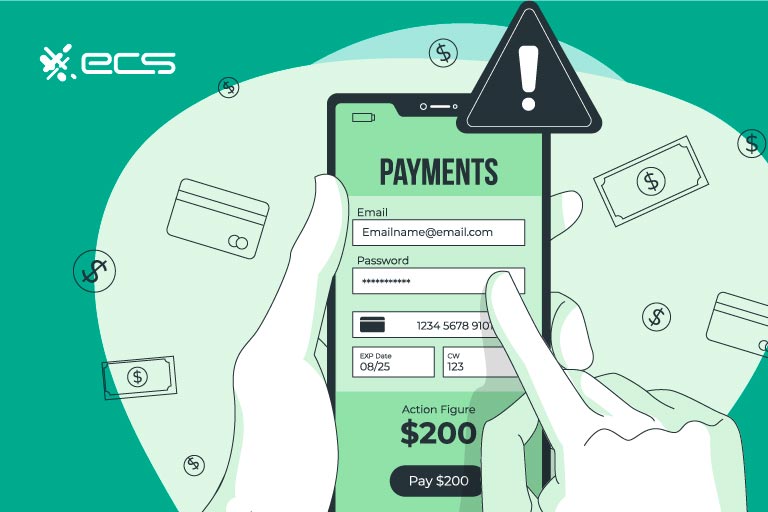Online payments are what make a majority of eCommerce possible. Without the easy digital transactions that online payment providers offer, most eCommerce businesses wouldn’t exist.
But even though online payments have been amazing for many businesses, they do still have their problems from time to time.
For years, merchants have had to deal with a few issues inherent to digital or electronic transactions. These can include things like cybersecurity fraud or having to deal with strict regulations from banks or other entities in the transaction flow.
Unfortunately, many of these are simply a part of processing online payments. But merchants can do a lot on their end to minimize the risks and impact of these online payment problems.
By implementing some simple steps and precautions, merchants can avoid these issues from harming their revenue and account status.
Below, we’ll go over the common online payment problems that merchants face as well as actionable tips to minimize the impact on your business.
Online Payment Fraud
Fraud is probably the main concern for many eCommerce businesses as it’s the issue that gets the most attention and can also be the most infuriating.
Experiencing fraud can make you feel like a victim and there is often little recourse to try to get some sense of justice.
But there are ways to minimize fraud and it starts with understanding the different kinds of fraud most prevalent with online payments.
Friendly Fraud
This type of fraud comes from seemingly friendly customers who are making normal purchases. Technically, it’s also called first-party fraud.
With friendly fraud, a customer will make a purchase using a valid credit card in their name. But the customer later claims the item never arrived. They may also simply claim that they never ordered the item and it must have been the result of someone stealing their information.
They then contact the issuing bank and ask for a chargeback.
Sometimes this can happen for innocent reasons. For example, someone makes a purchase but doesn’t remember it. The descriptor for the transaction on the customer’s statement may not be easy to decipher, causing them to suspect fraud and initiate a chargeback.
Another instance is if a family member makes the purchase without the knowledge of the cardholder. This can also lead to a chargeback. Merchants see this commonly with in-game purchases for video games, although it can happen with almost any product.
Finally, there is a situation where the customer rightfully or wrongly claims the product is defective.
In any of these cases, when the customer initiates a chargeback, it makes for a huge inconvenience for the merchant that could have been avoided.

How to Prevent Online Payment Friendly Fraud
There are few strategies to use to fight friendly fraud and most are relatively easy and don’t require a drastic change to your workflow.
Access Delivery Evidence
Make sure your order system captures delivery confirmation and also collects as much information as possible and then integrate this with your customer support or shopping platform
This means that your systems automatically capture and upload any delivery photos provided by the shipper. Most shopping platforms and customer service software offer this sort of integration when tied to your shipping accounts.
Make sure you have this enabled and you are using it so you have immediate evidence of packages being delivered.
Use Online Payment Tools Offered By Your Gateway Or Credit Card Issuers
The credit card issuers and payment gateways are very aware of fraud and provide many tools that merchants can use to help prevent fraud before it even happens
Work with your payment gateway and find out what tools and settings they have available to help you detect fraud in real-time.
Every gateway will be a little different and offer different solutions. For example, merchants using Authorize.net can apply several filters that put certain transactions into a pending status before sending them for final authorization.
These different pending review states include:
Process As Normal And Report Filter(s) Triggered
This is generally used for testing the effectiveness of fraud detection. Normal transaction processing occurs, but the filters will report any triggered fraud alerts.
Authorize And Hold For Review
This filter still authorizes transactions but allows the merchant to manually approve before settlement within 30 days.
Do Not Authorize But Hold For Review
This filter will place the transaction on hold before authorization. The merchant has 5 days to manually review the transaction. If no action is taken, the transaction is voided.
Decline The Transaction
This filter is the strictest, and it immediately declines any transaction that triggers it. Use caution with this filter although for some situations, it can be helpful.
This is just one example of the tools available through your gateway to help with fraud. You can also contact your payment processor for more assistance.
If you need a payment processor with reliable in-house customer support to help you with fraud, contact ECS Payments. We work with several gateways and also specialize in high-risk processing to help merchants avoid fraud and accept the most payments possible.

Other Types Of Online Payment Fraud
Merchants have to deal with other types of fraud that originate on different platforms, but the fraudulent card numbers are subsequently used on the merchant’s website.
Triangulation
This is where a malicious website is set up to steal customer billing information. For example, it can be a fake storefront or one made to look like a legitimate well-known website. When the customer enters their billing information, it is immediately stolen and passed on to fraudsters who use it at legitimate websites.
Clean Fraud And Identity Theft
These two types of fraud include the use of legitimate card data by someone posing as the actual cardholder. The fraudster generally has a good deal of knowledge of the original cardholder and may even control their email address and phone number to assist in the fraud.
For all of these additional types of fraud, it’s important to use your gateway’s tools along with the tools that your payment processor provides.
These tools include blacklists that can be used for filters to weed out problematic card numbers that have been flagged by the issuing banks.
If you process payments coming from foreign countries, you may notice certain countries have higher fraud or chargeback rates. You can set different filters for payments originating from these locations or block them altogether if needed.
Overall, combating fraud is a necessary part of accepting online payments. Working with a strong payment processor like ECS Payments can help you make this task much easier. Contact ECS Payments if you need help with fraud prevention or processing high-risk payments.
Online Payment Chargebacks
Chargebacks are one of the biggest problems for merchants and they occur when a customer disputes a transaction over a product or service. These can be both costly and also put your account at risk if left unchecked. Not only that, they take up time to manage and refute which could be spent on other more profitable tasks.
Managing chargebacks and understanding how chargebacks work should be a core part of your payment solution. By doing this you minimize the number of chargebacks and make it easier to refute these when they do happen.

Tips To Reduce Online Payment Chargebacks
Improve Customer Service
Many customers report they file a chargeback because they feel as though the eCommerce store is not providing adequate support for their issue. The customer feels the problem will never get resolved or the store is intentionally stalling. In this case, a chargeback is initiated by the customer that could have been avoided.
Many times, the store wasn’t stalling, they simply had poor customer service channels and the issue just fell through the cracks and became a chargeback.
Prevent this by improving your customer service channels and workflows. Explain to the customers that their problem will be solved and to be patient. If customers feel as though the store is working with them, they are much more patient and you will be less likely to have to deal with the chargeback process.
Respond To Support Requests Quickly
Responding to inquiries quickly also helps to drastically reduce chargebacks when customers dispute a charge. When a customer requests a refund or reports a missing or damaged item, respond the same day or at least within one day with a personalized response.
Feel free to ask for more information to verify their claims, but responding quickly heads off a possible chargeback. Customers expect fast communication these days, if they have to wait over a day, they become suspicious.
Online Payment Card And Customer Data Theft
Another problem for merchants when it comes to online payments is the liability and responsibility that comes with storing or transmitting sensitive billing information.
A data breach or hack can cause a company harm both financially and reputationally. Not only that, for some merchants, a data breach could mean they lose their merchant account or suffer other penalties.
However, there are many things merchants can do to mitigate this risk and remove this problem from online payments.
PCI Compliance
The first is to familiarize yourself with PCI compliance and the security requirements needed to ensure your network is PCI compliant.
PCI DSS stands for The Payment Card Industry Data Security Standard. These standards are created by the Payment Card Industry (PCI) Security Standards Council in coordination with credit card issuers. They can include things like the use of SSL certificates for your website and other best practices.
These guidelines are a set of online payment security requirements that all merchants need to follow and they are designed to reduce the risk of security issues when handling, storing, or transmitting credit card billing information.
The PCI DSS guidelines are divided into 4 levels, with each level based on the merchant’s processing volume.
- PCI Level 1 Requirements – $6 million or more in transactions per year
- PCI Level 2 Requirements – $1 million – $6 million in transactions per year
- PCI Level 3 Requirements – $20,000 – $1 million in transactions per year
- PCI Level 4 Requirements – $20,000 or less in transactions per year
To ensure you are fully compliant and also to find areas where you may need to improve, the PCI SCC provides a self-assessment questionnaire (SAQ). Depending on the nature of your processing, there are various SAQs for different merchants.
You can find a full list of SAQs here and determine which one you need for your business. You must answer every question in the affirmative or with “not applicable” to pass. Level 1 businesses need to perform a different audit, which must be performed by a third party or an internal employee who is trained appropriately.

Using Tools To Help With PCI Compliance
Another thing merchants can do to prevent data theft is to use the tools available from their gateway or payment processor.
Many popular gateways like NMI or Auhtorize.net offer tools such as hosted payment pages or secure storage for customer billing information. By using these tools, a merchant can offload a portion of their data security to the gateway.
This makes security much easier to manage and will generally allow for easier PCI compliance.
If you need help with PCI compliance or want to work with a payment gateway that offers the most tools, contact ECS Payments. We work with different payment gateways and help you find the one that’s perfect for your business.
Online Payment Integrations
This problem is a bit different as it can be both a problem but can also be an asset.
Many new merchants who start accepting online payments have a hard time understanding all of the different integrations available to them. Because of this, many new merchants end up doing manual data entry between their payment platform and their accounting software or other systems.
But once merchants understand how many payment integrations there are, they realize how strong these tools are at improving their workflow.
To help with this process, it’s important to pick the right payment gateway when deciding on a payment solution. Different payment gateways offer increased compatibility in certain areas, so it’s important to know which systems and software you already use and then pick the right gateway.
For example, if you use Quickbooks for accounting and Salesforce as a CRM, you will want to make sure to choose a payment gateway that offers easy integration with those platforms.
By doing this, you save yourself from a lot of headaches or manual data transfer from one system to another.

Confusing Online Payment Processing Fees
This problem can be very frustrating for merchants and it can also hurt their profitability if not managed properly.
Online payments do have fees attached to them. This is completely normal and the fees are required to maintain the network and keep everything running smoothly.
However, some fees are not always transparent and many merchants see these as “surprise fees” and a drag on their bottom line.
Minimum Fees
These are generally not that high, but they can still be a surprise to merchants. These fees happen when you don’t meet the minimum processing requirements.
To avoid these, make sure to be upfront and honest with your payment processor when setting up your estimated processing volumes. If you estimate too high, your minimum may be too high as well.
Overage Charge
Opposite to the minimum fee is the overage charge. This is when merchants exceed their credit and debit card processing limits and are sometimes charged a fee.
Going over your processing limit is a serious issue as it changes your risk profile. So large overages or consistent overages may cause you to lose your account. There may also be fees for minor overages.
Once again, it’s important to provide your payment processor with correct estimates of your processing volumes and if you expect an increase, inform your payment processor immediately.
Transparency Of Fees
Some payment processors may not be fully upfront with transaction fees and the different fee structures. This can cause quite a shock when the merchant sees their fees at the end of the month and adds them all up.
This is usually the case with smaller payment processors or acquiring banks that are not managed correctly. To combat this, always use a trusted payment processor like ECS Payments.
You want a processor with a long history in the online payment industry and one that is fully transparent with all their fees.
If you are working with a payment processor and you cannot get a straight answer about fees or notice extra fees, it may be time to find a different payment processor you can trust.
Final Tips For Dealing With Online Payment Problems
Online payments are crucial for a successful eCommerce business, but like everything, they have a few downsides.
By following the tips above, you should be able to either mitigate these problems or in some cases, avoid them altogether so you can focus on your business, not payment issues.
If you have additional payment issues you need help with, contact our experts at ECS Payments. Our team helps merchants in different industries leverage the best payment solutions to maximize their profit and sales potential.
Contact ECS Payments Sales to learn more about how we can help your business succeed with the latest in online payment services.
